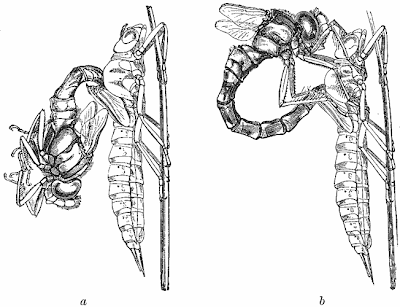A dragonfly is a flying insect characterized by large multifaceted eyes, two pairs of strong transparent wings, and an elongated body. Like any other insect, dragonflies also possess six legs, but most species are unable to walk on them with any competence.
 |
| What is a dragonfly? |
However, large dragonflies - like the hawkers - have been reliably measured at a maximum speed of 22–34 mph, with average cruising speed of about 10 mph.
What do dragonflies eat?
Dragonflies are important predators that eat predominantly small insects such as mosquitoes, flies, bees, ants, wasps, and very rarely butterflies. They are usually found around marshes, lakes, ponds, streams, and wetlands because their larvae, known as 'nymphs', are aquatic. They are an almost global predator with some 5680 different species known in the world today.
Though dragonflies are predators, they themselves are subject to predation by birds, lizards, frogs, spiders, fish, water bugs, and even larger dragonfly species.
Dragonfly life-cycle
 |
| What is a dragonfly? |
They breathe through gills in their rectum, and can rapidly propel themselves by suddenly expelling water through the anus - lovely! Some nymphs even hunt on land, an aptitude that could easily have been more common in ancient times when terrestrial predators were clumsier.
The larval stage of large dragonflies may last as long as five years. In smaller species, this stage can last anywhere between two months and three years.
 |
| What is a dragonfly? |
In flight the adult dragonfly can propel itself in six directions; upward, downward, forward, back, and side to side. The adult stage of larger species of dragonfly can last as long as five or six months.
Dragonflies can sometimes be mistaken for damselflies, which are morphologically similar; however, adults can be differentiated by the fact that the wings of most dragonflies are held away from, and perpendicular to the body when at rest.
For related articles click onto the following clicks:
THE LEAF INSECTS
THE ORCHID MANTIS
WHAT IS A DRAGONFLY?
THE LEAF INSECTS
THE ORCHID MANTIS
WHAT IS A DRAGONFLY?







No comments:
Post a Comment